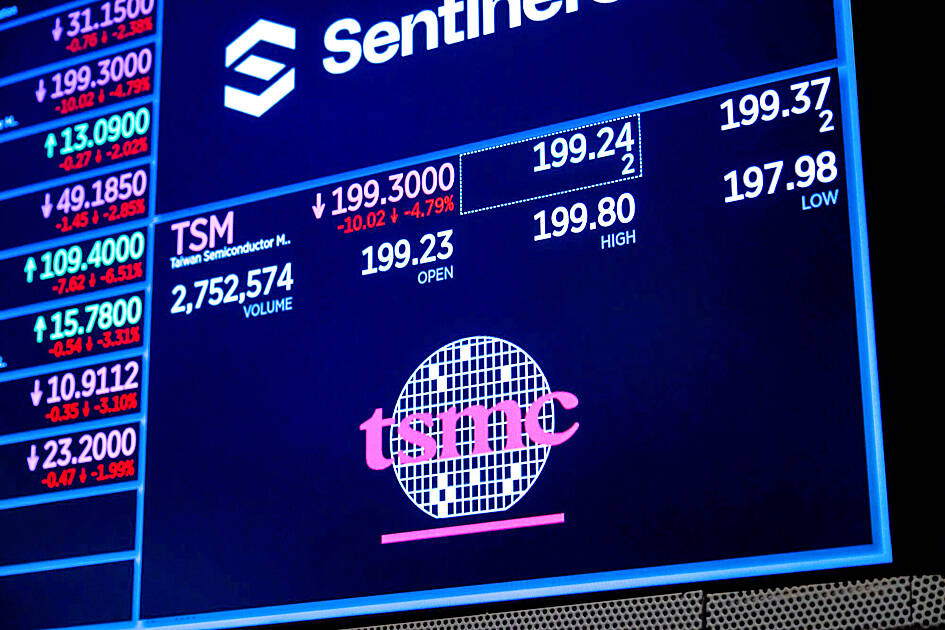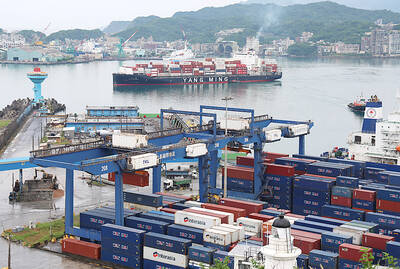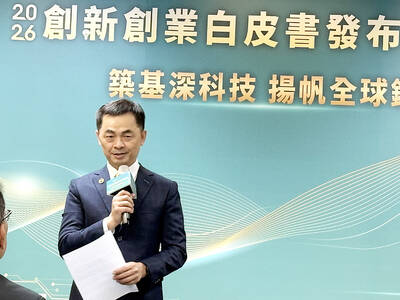Three experts in the high technology industry have said that US President Donald Trump’s pledge to impose higher tariffs on Taiwanese semiconductors is part of an effort to force Taiwan Semiconductor Manufacturing Co (TSMC, 台積電) to the negotiating table.
In a speech to Republicans on Jan. 27, Trump said he intends to impose tariffs on Taiwan to bring chip production to the US.
“The incentive is going to be they’re not going to want to pay a 25, 50 or even a 100 percent tax,” he said.

Photo: Bloomberg
Darson Chiu (邱達生), an economics professor at Taichung-based Tunghai University and director-general of the Taipei-based Confederation of Asia-Pacific Chambers of Commerce and Industry, on Saturday said that TSMC’s orders are currently at full capacity, especially with the rise of artificial intelligence (AI), where demand for high-end chips exceeds supply and there are no viable substitutes.
That means that TSMC is a price-setter in the market, rather than a price-taker, Chiu said.
As a result, the more tariffs imposed on TSMC chips, the higher the costs US importers would have to bear, which could lead to inflation and ultimately be passed on to domestic consumers.
Unlike the US tariffs on Chinese products such as plastics, where importers can switch to suppliers from countries such as Vietnam, “TSMC’s chips cannot be easily replaced, even Intel struggles to produce them,” he said.
Eventually, US importers would have no choice but to pay the higher tariffs, he said.
Given that Trump’s advisers are highly respected economic academics, who would certainly not introduce a tariff policy without having considered its impact on the competitiveness of the US AI sector, what Trump really wants is probably to force TSMC to the negotiating table, Chiu said.
Meanwhile, Hsieh Chin-ho (謝金河), chairman of the Chinese-language Wealth Magazine, on Saturday said that he believes Trump hopes to pressure TSMC into increasing its investment in the US.
He said that TSMC, the world’s largest contract chipmaker, should extend goodwill toward the Trump administration.
Taipei-based former Bloomberg Opinion columnist Tim Culpan in an online opinion piece on Friday said that if Trump goes further than stand-alone chips and adds import duties to a broader category of semiconductor products including graphics processing units, modules and subsystems, then the results could be “disastrous.”
“The US doesn’t have the capacity to manufacture anywhere near a similar volume of equivalent devices. It would take months, if not years, to build the factories, spin up the tools, and then go through the qualification process,” he wrote in the article titled “How a TSMC Tax Would be a FAFO Move for the US.”
In the opinion piece, Culpan said that the US could impose a tax on Taiwanese chips, but it would hurt the very companies Trump used to bolster his tech credentials.
TSMC would not be the one to suffer the most if Trump imposes the tariff hike, Culpan said.
“The company is capacity constrained in advanced-packaging for AI chips and clients have no other choice,” he wrote.
“In fact, the biggest victims would be the three men who so proudly and obsequiously fawned over the new president the first full day he was in office: Larry Ellison, Sam Altman and Masayoshi Son,” he said.
Ellison, Altman and Son head Oracle Corp, OpenAI and Softbank Group Corp respectively.
“What I think Trump really wants is for TSMC to kiss the ring and pledge to invest more in the US,” he wrote.

Taiwan’s exports soared 56 percent year-on-year to an all-time high of US$64.05 billion last month, propelled by surging global demand for artificial intelligence (AI), high-performance computing and cloud service infrastructure, the Ministry of Finance said yesterday. Department of Statistics Director-General Beatrice Tsai (蔡美娜) called the figure an unexpected upside surprise, citing a wave of technology orders from overseas customers alongside the usual year-end shopping season for technology products. Growth is likely to remain strong this month, she said, projecting a 40 percent to 45 percent expansion on an annual basis. The outperformance could prompt the Directorate-General of Budget, Accounting and

Two Chinese chipmakers are attracting strong retail investor demand, buoyed by industry peer Moore Threads Technology Co’s (摩爾線程) stellar debut. The retail portion of MetaX Integrated Circuits (Shanghai) Co’s (上海沐曦) upcoming initial public offering (IPO) was 2,986 times oversubscribed on Friday, according to a filing. Meanwhile, Beijing Onmicro Electronics Co (北京昂瑞微), which makes radio frequency chips, was 2,899 times oversubscribed on Friday, its filing showed. The bids coincided with Moore Threads’ trading debut, which surged 425 percent on Friday after raising 8 billion yuan (US$1.13 billion) on bets that the company could emerge as a viable local competitor to Nvidia

BARRIERS: Gudeng’s chairman said it was unlikely that the US could replicate Taiwan’s science parks in Arizona, given its strict immigration policies and cultural differences Gudeng Precision Industrial Co (家登), which supplies wafer pods to the world’s major semiconductor firms, yesterday said it is in no rush to set up production in the US due to high costs. The company supplies its customers through a warehouse in Arizona jointly operated by TSS Holdings Ltd (德鑫控股), a joint holding of Gudeng and 17 Taiwanese firms in the semiconductor supply chain, including specialty plastic compounds producer Nytex Composites Co (耐特) and automated material handling system supplier Symtek Automation Asia Co (迅得). While the company has long been exploring the feasibility of setting up production in the US to address

OPTION: Uber said it could provide higher pay for batch trips, if incentives for batching is not removed entirely, as the latter would force it to pass on the costs to consumers Uber Technologies Inc yesterday warned that proposed restrictions on batching orders and minimum wages could prompt a NT$20 delivery fee increase in Taiwan, as lower efficiency would drive up costs. Uber CEO Dara Khosrowshahi made the remarks yesterday during his visit to Taiwan. He is on a multileg trip to the region, which includes stops in South Korea and Japan. His visit coincided the release last month of the Ministry of Labor’s draft bill on the delivery sector, which aims to safeguard delivery workers’ rights and improve their welfare. The ministry set the minimum pay for local food delivery drivers at